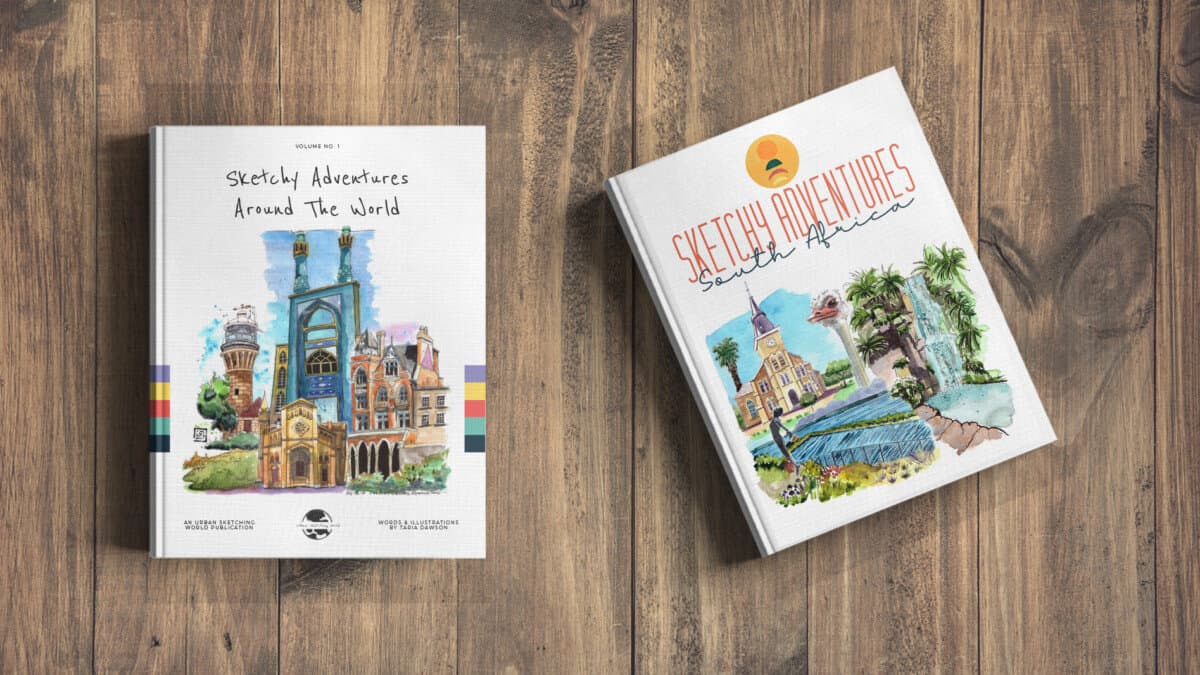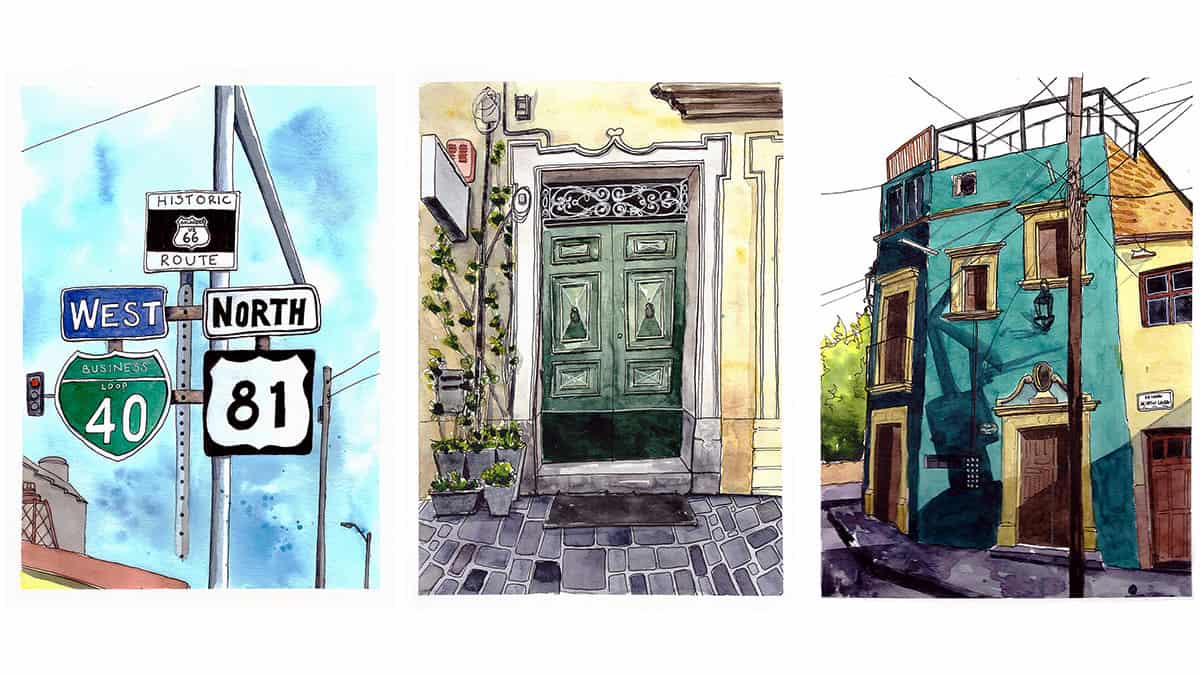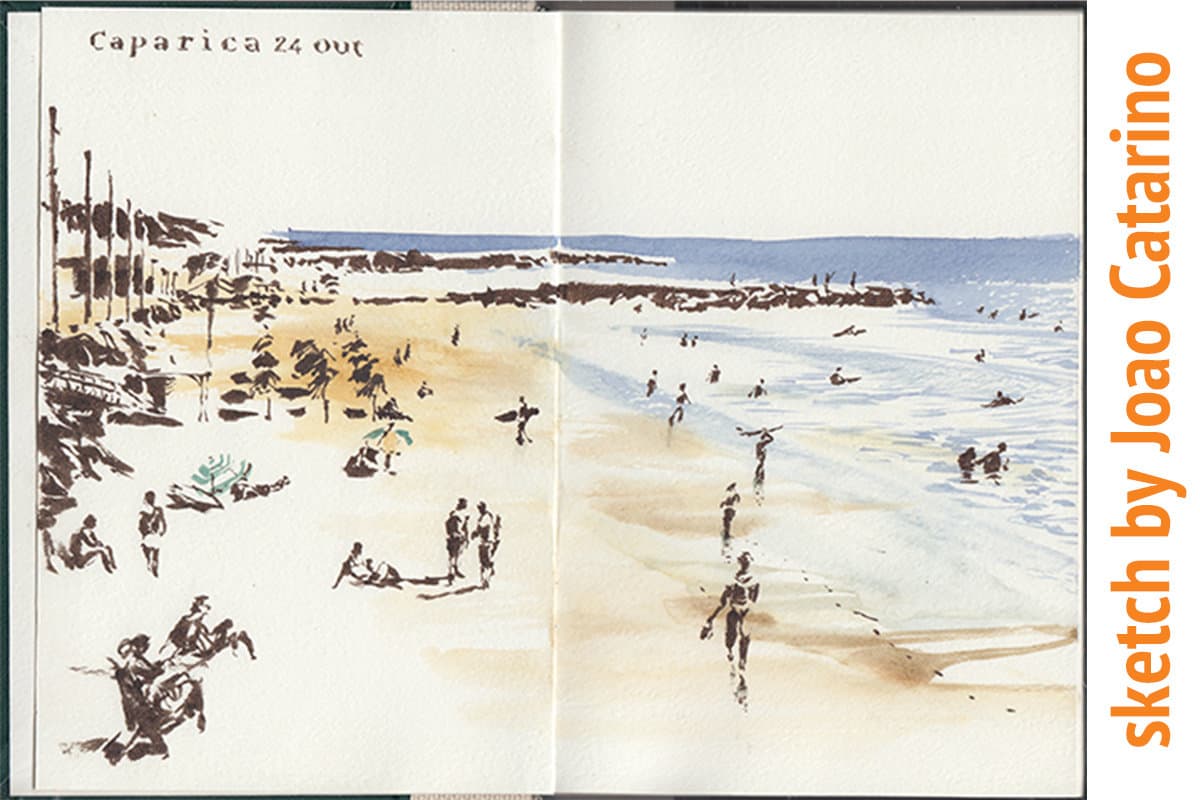Minimalism in urban sketching is a style that emphasises the use of clean lines, limited colour palettes, and the deliberate omission of unnecessary details. By simplifying their sketches, these urban sketchers are able to capture the essence of a scene and convey its atmosphere with just a few well-placed strokes.
Today I want to show you 5 of my favourite urban sketchers who epitomise the minimalist sketching style.
Let’s delve into how they manage to sketch less, yet produce more visual impact.
Make sure to read to the end of this post as I also give some top tips on how you can become more minimalist with your urban sketching.
For those of you who don’t know me, I am Taria and I run this blog (urbansketchingworld.com) as well as a Youtube channel (Taria’s Sketchy Adventures) which covers urban sketching, travel sketching as well as tutorials and sketchbook experimentations. If you want to learn how to let go and sketch, go check out learn.sketchyouradventures.com.
Now, let’s take a closer look at each of these talented urban sketchers who have mastered the art of minimalist sketching.
The urban sketchers I am going to discuss in this post are:
- Tiago Cruz
- Lis Watkins
- Emily Thomas
- Jim Butler
- Joao Catarino
I want to give a special mention to John Harrison. Some of you who have been following me for a while and watching my Youtube channel know I love his style. John even kindly agreed to an interview with me which you can watch below:
As I have mentioned him and his work a lot before, I thought I should try and introduce you to some sketchers you may not have encountered.
Tiago Cruz
Tiago Cruz’s sketches transport you to bustling city streets with their effortless simplicity. His compositions often feature bold, confident lines that capture the architectural elements of the urban landscape. Cruz’s use of negative space is particularly noteworthy, as he skillfully leaves areas blank to create a sense of balance and harmony within his sketches.
I particularly love his consistent use of an A6 sketchbook plus the loose watercolour stroke in the background. I wonder which comes first – the background or the line drawing. From looking at this particular example I suspect the background was first as the ink lines are particularly striking and don’t look like they have had watercolour applied on top of them. That’s my hunch but I could be wrong!
I think Tiago’s style epitomises the concepts of economy of line and colour. I am a huge fan of his style and love scrolling through his Instagram profile. I am always envious of people with beautifully consistent Instagram feeds! Also, look out for the odd sketch that he has subtly added to using digital media.
Lis Watkins
Lis Watkins is a professional illustrator based in London. She specialises in travel illustration and prefers to draw on location whenever possible. She is an active member of USK London. She also has a wonderful blog here: https://www.lineandwash.co.uk/ which I encourage you to explore. She is such an inspiring sketcher and I am a huge fan of her work.
Lis has a unique ability to distil the energy and character of urban environments into minimalist sketches. Through her clean linework and limited colour palette, she creates scenes that are understated yet captivating.
Lis’s sketches often focus on the interplay of light and shadow, showcasing her keen observation skills and attention to detail.
Check out my ebooks with hundreds of ink & watercolour travel sketches from all over the world. Get some inspiration for your next trip…

Emily Thomas
Emily Thomas is a reportage illustrator also based in London. I think I discovered her work when going deeper into the topic of reportage illustration. (For more information on what reportage illustration is, check out my post here). I find this subject fascinating. The work of contemporary reportage illustrators such as George Butler, Lucinda Rogers and Lyndon Hayes really excites me.
I discovered Emily through her work as an artist in residence at West Middlesex University Hospital as well as at Chelsea and Westminster Hospital in 2020, which must have been an interesting time to be in the midst of an overwhelmed healthcare facility, to say the least.
As a reportage illustrator, the skill of saying more with less is absolutely essential.
I think Lyndon Hayes and Lucinda Rogers’s work could have easily been on the list but I am saving those 2 gems for a blog post on another subject matter! (Watch this space).
You can absolutely see the “less is more” principle in George Butler’s work too:
Emily’s sketches are characterised by their simplicity and a strong sense of composition. Emily excels in capturing the essence of a place with just a few well-placed lines, allowing viewers to fill in the gaps with their own imagination. Her work reminds us that less can truly be more when it comes to urban sketching.
Want to learn travel sketching in ink & watercolour?
Check out my course, Sketch Your Adventures and for a limited time get 50% OFF!!!

Jim Butler
Jim Butler is an artist and printmaker from Dublin, living in the UK. He is also a lecturer in Illustration at the Cambridge School of Art. Jim takes his inspiration from the urban environment and draws with ink and collage directly on location.
Jim Butler’s sketches are a masterclass in using minimalism to evoke a sense of mood and atmosphere. He often employs a limited colour palette, relying on subtle washes and precise linework to convey the essence of a place.
Jim’s sketches invite viewers to explore the urban landscape through their own interpretation, leaving room for imagination and personal connection.
João Catarino
I don’t know too much about Joao Catarino but I do know he lives in Portugal and he loves surfing. Oh, and he is an urban sketcher of course! I also know he is an illustration and drawing teacher. He has also been an instructor at several Urban Sketchers Symposiums in the past.
João Catarino’s minimalist sketches capture the essence of urban life in a way that is both striking and thought-provoking. His use of bold shapes and negative space creates a sense of simplicity and tranquillity, despite the bustling scenes he sometimes portrays.
I particularly love João’s way of depicting water and sand. The way he says so much with so few brush marks, often directly in watercolour, i.e. no drawing is masterful in my opinion.
Catarino’s sketches often focus on the human element, depicting people going about their daily lives in the urban environment, adding a touch of storytelling to his minimalist approach.
Final Thoughts…
In conclusion, these five urban sketchers demonstrate the power of minimalism in capturing the essence of a scene. Through their deliberate use of clean lines, confident brush strokes, limited colour palettes, and omission of unnecessary details, they are able to create sketches that leave a lasting impact.
Whether it’s the architectural beauty, the interplay of light and shadow, or the human element, these artists show us that less can truly be more in the world of urban sketching.
For tips on how you can master the art of minimalism in urban sketching, check out the second post in this series here.
Some of my favourite online classes
- Watercolor Portrait Sketchbook – Carlos Rodriguez Casado
- Expressive Architectural Sketching with Colored Markers – Albert Kiefer
- Experimental Watercolour Techniques For Beginners – Ana Santos
- Urban Sketching: Express Your World in a New Perspective – Lapin

